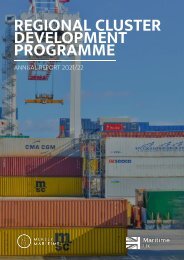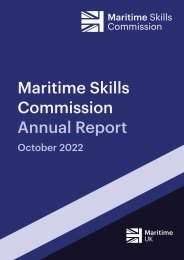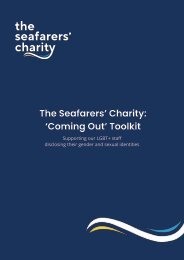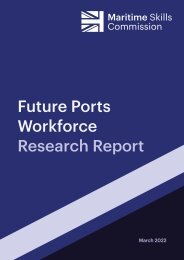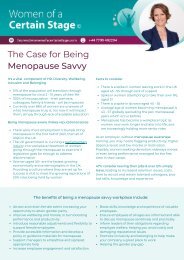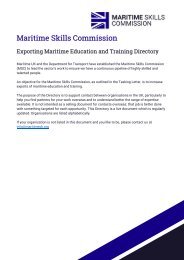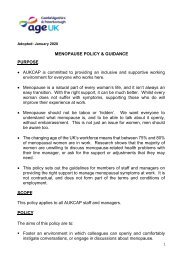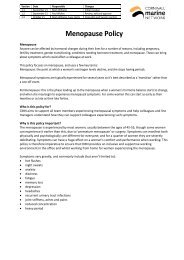COP_2023_V7_pages
You also want an ePaper? Increase the reach of your titles
YUMPU automatically turns print PDFs into web optimized ePapers that Google loves.
10.12.3 In the case of an automatic operator, the design of that controller or supervisor shall be fail safe, in that it<br />
shall recognise all known unsafe operating conditions with no false negatives and shall react to unknown or<br />
indeterminate safety conditions by invoking Emergency Stop in a timely manner.<br />
10.12.4 On sensing a failure (or disabling, whether deliberate or not) of all data-links which may carry an emergency stop<br />
command, the MASS shall enter a ‘render-safe’ procedure. This should culminate in Emergency Stop. The first action<br />
should be that, if situational awareness has been, and continues to be, fully operational, the MASS should<br />
immediately shape a safe course and adopt a ‘safe speed’ (making appropriate sound and visual signals when<br />
feasible) commensurate with weather conditions, COLREGS and safe navigation at the time of loss of data-link.<br />
This should minimise hazards to the MASS and other vessels, whilst the MASS and the control station resolve the<br />
situation. If the data-link is not re-established after an appropriate grace time, and/or the MASS’s own situational<br />
awareness deems it safe/necessary, the MASS should enter Emergency Stop. Consideration may be made of including<br />
‘dropping anchor’ as part of the render-safe procedure, commensurate with accepted safe navigation practices.<br />
10.12.5 In the event that the MASS experiences loss or compromise of Situational Awareness as well as loss of data-link, then<br />
Emergency Stop should be immediately initiated (making appropriate sound and visual signals when appropriate).<br />
10.13 PROPULSION CONTROL<br />
10.13.1 MASS should have propulsion control as far as necessary to be capable of ensuring that safe operating speeds<br />
appropriate to its situation are not exceeded.<br />
10.14 STEERING CONTROL<br />
10.14.1 The MASS should have steering control as may be necessary to maintain a safe heading. Note that ‘passive’<br />
MASS, such as drifting sensor buoys, do not have steering control, but the risk is mitigated by deploying in safe<br />
areas and monitoring their position, and maintaining the ability to recover the MASS when necessary.<br />
10.14.2 Note on Heading vs Course Over ground (COG). Marine craft may have control of heading but limited control of<br />
Course Over Ground (COG) because of environmental influences such as surface currents, waves, or wind,<br />
combined with low Speed Through the Water (STW). The risk posed by potential loss of control over COG shall<br />
be addressed by means of situational awareness, using sensor and almanac data or calculations as necessary<br />
to anticipate environmental influences, so as to avoid bringing the MASS into a situation where it is predictably<br />
carried in an unsafe direction by overwhelming environmental influences.<br />
10.15 COLREG – COMPLIANT BEHAVIOURS AND FAIL-SAFES<br />
10.15.1 The Control System shall be capable of operating to a level of compliance with COLREGS appropriate to the<br />
MASS class.<br />
10.15.2 The Control System may include a system or systems designed to sense and avoid obstacles. These obstacles<br />
may be fixed (e.g. coastline) or moving (drifting or other craft).<br />
10.15.3 Sense and Avoid systems may be deemed necessary:<br />
n When operating within Line of Sight (LOS), as directed by area control authorities;<br />
n When operating outside LOS.<br />
86<br />
MASS UK Industry Conduct Principles and Code of Practice Version 7





